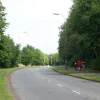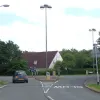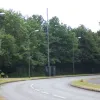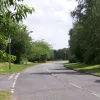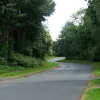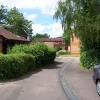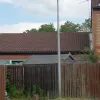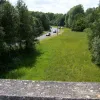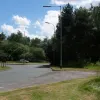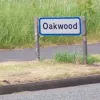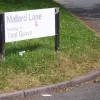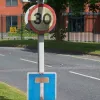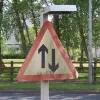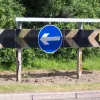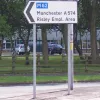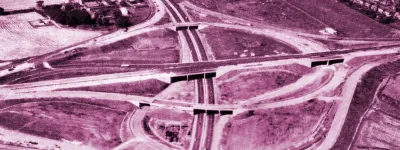If you're going to build a whole new urban area, your job is made considerably more easy if you can design a set of stock elements to be used as the building blocks of the plan. And so it was with Warrington - a standard layout for main roads, a standard set of five or six designs for houses, a standard type of streetlight for housing estates, and so on.
Additionally, the New Town districts were planned with a clear heirarchy of roads. At the top level were the planned expressways, and immediately below them main roads, local distributors, estate roads, closes and lanes. The idea was that the design of each level would inform the driver of their increasingly urban setting. This page examines those types of road and the street furniture selected to use on them.
An example of one of the main roads, occasionally dualled but mostly single-carriageway. Here, Ordnance Avenue is a typical example, with excellent sightlines and extensive landscaping. (Warrington Borough Council have decided to err on the side of caution, however, and this road is a 30 limit.) Note the tall, curved lights with orange sodium lamps.
This miniature roundabout is typical of many within the residential districts, though busier routes and industrial areas tended to have larger examples. It has an attempt at feature lighting, and is actually used here as a gateway to the 'centre' of one of the residential areas, intended to slow traffic approaching the school and shops.
Below the main road on the heirarchy is the local distributor, frequently running in semi-circular loops through residential areas. These roads have mid-sized streetlights with bright white lamps - perhaps because of the increased likelihood of pedestrians. Even so, the road seems no more built up than the last.
Another example of the local distributor, though this one (Admirals Road) is more obviously passing through a housing estate and encounters frequent bus stops and side turnings. None of the local distributors have any frontage development.
Off the local distributor, all roads are dead-ends. This estate road is the main access for one cluster of streets, and immediately feels smaller and more enclosed - though there's still no sign of development! Just behind the camera it enters a group of houses and is lined with parking bays.
Deep within the housing estate are these lanes - designed to be narrow and enclosed, with poor sightlines that force drivers to slow right down. There are no footways and the jumble of houses seems to be an attempt at making a planned estate look more naturally developed.
This is one of the few remaining examples of the original lights used within the housing estates. The vast majority have been replaced, and with good reason: it's impossible to say how effective they were when first installed, but today these lights emit a pale greenish glow (most of which is lost out of the top of the lamp) that does nothing to brighten the street.
This section of road is the main access from Birchwood Way to the Birchwood Centre. Like several other New Town roads it has space left for future dualling - here, as it approaches the Oakwood Gate roundabout, it passes under one side of a three-span footbridge.
The entrance to the roundabout itself was built and is often used as a lay-by for visitors who have become lost in the maze of roundabouts.
Each residential zone has its own name - some original to the area, like Locking Stumps, Gorse Covert and Cinnamon Brow, others invented for the New Town and rather bland, like Oakwood and Birchwood. Each area is heralded by a small sign in the verge on its approaches.
The original street name signs are rapidly disappearing - largely because they are made of fibreboard and are quite easy to kick in half. But they have a very smart New Town feel to them that the newer signs can't match.
Warrington New Town's real signature is its road signing, which appears to have been specially produced (though why exactly, I can't imagine). It's constructed of box-sections, with the lamp and its support all built in and made to look like part of the grey metal construction.
This picture shows the blocky construction of the lamp more clearly. Unfortunately these are disappearing very quickly.
Even the one-piece roundabout signs were produced this way, though this one has had a new blue arrow sign added more recently.
One of the most unusual points is that the utilitarian names that the Development Corporation assigned to the zones in their plan made it onto road signs and are still being put on them even today. Look hard enough and you'll find no shortage of signs like this one pointing to "Risley Employment Area".
